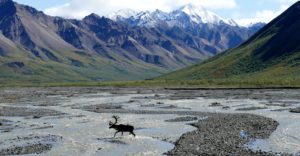When approaching the coasts of Alaska, the Cousteau Crew was amazed by the enormity of the state, the largest in the US. Alaska encompasses 1,525,000 square kilometers yet is home to only 600,000 inhabitants, and one can walk for days without meeting another human being. This wild expanse is home to the polar bear, grizzly bear, and walrus, as well as people persecuted, exploited, enslaved, and decimated by diseases introduced by colonists.

When Alcyone explored the Glacier Bay region in 1987 and 1988, the crew felt like they had traveled 80,000 years back in time to when parts of Europe and North America were covered in ice. During this voyage, Alcyone would be tossed from side to side by the waves created by massive sheets of ice crumbling into the water. Captain Cousteau, through the films produced during these expeditions, such as Twilight of the Alaskan Hunter, showed how Alaska holds many key components that could allow the state to serve as a model of management of its natural regions, such as substantial financial resources, a high level of education, and a small population in an immense territory.
During his exploration, Cousteau realized that, if authorities were wise, this “last frontier” could remain a unique place where humans and animals cohabit without serious problems. However, in 1989, the tanker Exxon Valdez ran aground on a reef off the southern coast, spilling oil directly in the middle of a magnificent landscape of pristine wilderness, especially rich in species diversity and home to migratory birds, young salmon swimming to the sea and adults returning to reproduce, seals hauling out on shore, sea otters, and orca whales. Several days after the catastrophe, the Cousteau team arrived on site and took stock of the damage: 1,000 kilometers of coast contaminated, and thousands of birds and mammals dead. The tragedy symbolizes a major dilemma facing our planet today: harnessing natural resources without vandalizing the environment.
Saving and protecting marine life for present and future generations since 1973
©2024 The Cousteau Society.
All rights reserved.